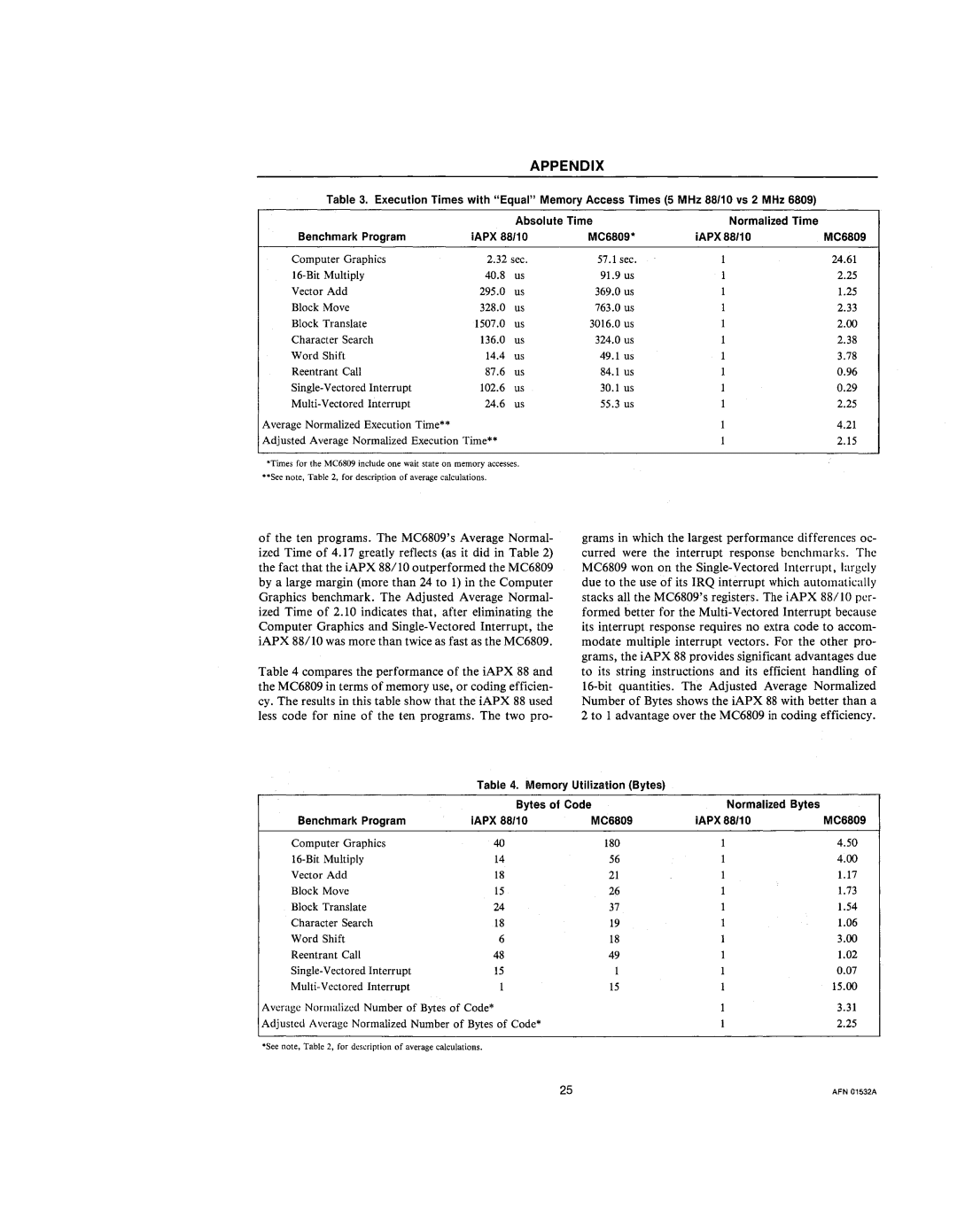
APPENDIX
Table 3. Execution Times with "Equal" Memory Access Times (5 MHz 88/10 vs 2 MHz 6809) |
| ||||
|
| Absolute Time | Normalized Time |
| |
Benchmark Program | iAPX 88110 | MC6809* | iAPX88/10 | MC6809 | |
Computer Graphics | 2.32 sec. | 57.1 sec. |
| 24.61 | |
40.8 | us | 91.9 us |
| 2.25 | |
Vector Add | 295.0 | us | 369.0 us |
| 1.25 |
Block Move | 328.0 | us | 763.0 us |
| 2.33 |
Block Translate | 1507.0 | us | 3016.0 us |
| 2.00 |
Character Search | 136.0 | us | 324.0 us |
| 2.38 |
Word Shift | 14.4 | us | 49.1 us |
| 3.78 |
Reentrant Call | 87.6 | us | 84.1 us |
| 0.96 |
102.6 | us | 30.1 us |
| 0.29 | |
24.6 | us | 55.3 us |
| 2.25 | |
Average Normalized Execution Time·" |
|
|
|
| 4.21 |
Adjusted Average Normalized Execution Time·· |
|
|
| 2.15 | |
*Times for the MC6809 include one wait state on memory accesses.
··See note, Table 2, for description of average calculations.
of the ten programs. The MC6809's Average Normal- ized Time of 4.17 greatly reflects (as it did in Table 2) the fact that the iAPX 88/10 outperformed the MC6809 by a large margin (more than 24 to 1) in the Computer Graphics benchmark. The Adjusted Average Normal- ized Time of 2.10 indicates that, after eliminating the Computer Graphics and
Table 4 compares the performance of the iAPX 88 and the MC6809 in terms of memory use, or coding efficien- cy. The results in this table show that the iAPX 88 used less code for nine of the ten programs. The two pro-
grams in which the largest performance differences oc- curred were the interrupt response benchmarks. The MC6809 won on the
| Table 4. Memory Utilization (Bytes) |
|
| |
| Bytes of Code | Normalized Bytes |
| |
Benchmark Program | iAPX 88/10 | MC6809 | iAPX 88/10 | MC6809 |
Computer Graphics | 40 | 180 |
| 4.50 |
14 | 56 |
| 4.00 | |
Vector Add | 18 | 21 |
| 1.17 |
Block Move | 15 | 26 |
| 1.73 |
Block Translate | 24 | 37 |
| 1.54 |
Character Search | 18 | 19 |
| 1.06 |
Word Shift | 6 | 18 |
| 3.00 |
Reentrant Call | 48 | 49 |
| 1.02 |
15 | 1 |
| 0.D7 | |
Multi- Vectored Interrupt |
| 15 |
| 15.00 |
Average Normalized Number of Bytes of Code" |
|
| 3.31 | |
Adjusted Average Normalized Number of Bytes of Code· |
|
| 2.25 | |
"'See note, Table 2, for description of average calculations.
25 | AFN 01532A |
